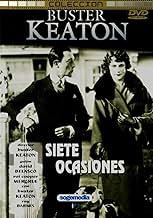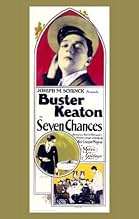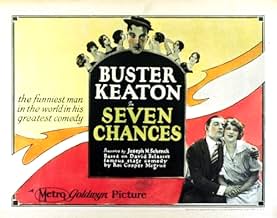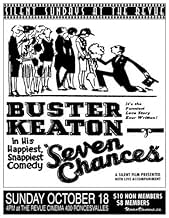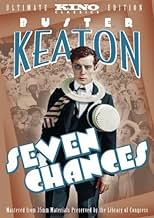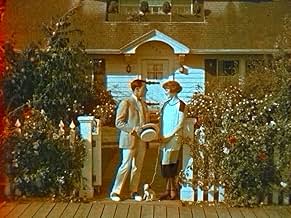AVALIAÇÃO DA IMDb
7,8/10
12 mil
SUA AVALIAÇÃO
Em seu aniversário de 27 anos, um rapaz descobre que seu avô lhe deixou uma herança de 7 milhões de dólares com a condição de estar casado às 19h naquele mesmo dia e tem poucas horas para en... Ler tudoEm seu aniversário de 27 anos, um rapaz descobre que seu avô lhe deixou uma herança de 7 milhões de dólares com a condição de estar casado às 19h naquele mesmo dia e tem poucas horas para encontrar uma noiva.Em seu aniversário de 27 anos, um rapaz descobre que seu avô lhe deixou uma herança de 7 milhões de dólares com a condição de estar casado às 19h naquele mesmo dia e tem poucas horas para encontrar uma noiva.
- Prêmios
- 1 vitória e 1 indicação no total
Frances Raymond
- Her Mother
- (as Frankie Raymond)
Jean Arthur
- Miss Smith - Office Receptionist
- (não creditado)
Lori Bara
- Mother of Underage Girl
- (não creditado)
Rosalind Byrne
- Locker Room Maid
- (não creditado)
Louise Carver
- Prospective Bride Who Operates Crane
- (não creditado)
Enredo
Você sabia?
- CuriosidadesThe most famous scene of this film originated by accident. In the filming of a chase scene down a steep slope, Buster Keaton inadvertently dislodged some rocks which tumbled after him as if in pursuit, and he had to scramble to dodge them. At a preview showing, Keaton saw that that accident got the biggest laughs in the film. Thus inspired, he decided to reshoot the scene with over 100 papier-mâché "rocks", ranging from pebbles to six-foot boulders, so his character would have to deal with a massive avalanche in the scene.
- Erros de gravaçãoJust as the horde of would-be brides overruns the college football game, one of the players can be seen throwing himself to the ground, already pretending to be trampled.
- Citações
Title Card: By the time Jimmie had reached the church, he had proposed to everything in skirts, including a Scotchman.
Avaliação em destaque
True love takes a lot of work - but this is ridiculous!
Jimmie Shannon (Buster Keaton) is a partner in a brokerage who can't quite bring himself to propose to Mary (Ruth Dwyer), the only woman he loves. Then, his business facing ruin, he discovers he stands to inherit a fortune if only he gets married that day. He proposes to Mary, but she's put off by his apparent insincerity. So Jimmie is left to find a woman, any woman, who will marry him. Will love prevail?
The film is an odd one for Keaton, starting off with a brief color sequence (in 1925) and moving quite slowly for Buster through the first third. The story was one Keaton had handed to him, rather than one he worked on himself, and feels at times like a "ladies' picture," focusing as it does on Jimmie's frustrated feelings and Mary's unhappiness.
For a while, Buster's not even the main laugh-getter in the film. For a while, he plays a kind of straight man to troll-visaged Snitz Edwards, playing the lawyer bringing the news of Jimmie's inheritance. Snitz chases after Jimmie and his partner, who think he's a process-server and dodge him, but Snitz prevails. Buster still pines for Mary, saying he can love no other woman (which she happens to hear over a telephone connection, changing her mind), but agrees to bring to bring a woman to church before the deadline out of loyalty to his partner.
"In case two show up, I'll marry the other," Snitz declares.
There are other oddities about "Seven Chances," like racial humor (Jimmie almost proposes to a black woman; a blackface actor plays a thick-headed hired hand) and the "Saphead"-style character Buster plays. It would seem like a lesser Keaton for that, but instead emerges as a masterwork of pacing and narrative. Just as you begin to settle in to "Seven Chances" tea-cozy aesthetic, it ramps things up for one of the great double-rally endings in movie history.
There's also a charming sequence where Jimmie tries to find a bride among a list of female members of his country club, the "seven chances" of the film's title. He burns through those chances in six minutes, and then gets rejected by a receptionist (Jean Arthur) and a hat-check girl (Rosalind Byrne) for good measure. The sequence plays with set design and framing to keep you always wondering as to what will happen next.
One amazing thing about the film you might not notice is the clever use of panning. Camera pans were still fairly new in cinema; framing was often stationary. But Buster is always in motion, and the camera moves with him. One clever shot, of Buster finding a turtle attached to his tie, apparently employs a treadmill in order to achieve an overhead camera angle.
The gags here keep coming, and give "Seven Chances" the feel of a classic Keaton short. Except there's a real story here to be told, and the humor always works to move the ideas forward. It's a classic demonstration of Keaton's ingenuity - even if he didn't have a hand in the film's conception or writing he directed it, and it shows - as well as his ability to find as many ways of making you laugh in as little time as possible.
Jimmie Shannon (Buster Keaton) is a partner in a brokerage who can't quite bring himself to propose to Mary (Ruth Dwyer), the only woman he loves. Then, his business facing ruin, he discovers he stands to inherit a fortune if only he gets married that day. He proposes to Mary, but she's put off by his apparent insincerity. So Jimmie is left to find a woman, any woman, who will marry him. Will love prevail?
The film is an odd one for Keaton, starting off with a brief color sequence (in 1925) and moving quite slowly for Buster through the first third. The story was one Keaton had handed to him, rather than one he worked on himself, and feels at times like a "ladies' picture," focusing as it does on Jimmie's frustrated feelings and Mary's unhappiness.
For a while, Buster's not even the main laugh-getter in the film. For a while, he plays a kind of straight man to troll-visaged Snitz Edwards, playing the lawyer bringing the news of Jimmie's inheritance. Snitz chases after Jimmie and his partner, who think he's a process-server and dodge him, but Snitz prevails. Buster still pines for Mary, saying he can love no other woman (which she happens to hear over a telephone connection, changing her mind), but agrees to bring to bring a woman to church before the deadline out of loyalty to his partner.
"In case two show up, I'll marry the other," Snitz declares.
There are other oddities about "Seven Chances," like racial humor (Jimmie almost proposes to a black woman; a blackface actor plays a thick-headed hired hand) and the "Saphead"-style character Buster plays. It would seem like a lesser Keaton for that, but instead emerges as a masterwork of pacing and narrative. Just as you begin to settle in to "Seven Chances" tea-cozy aesthetic, it ramps things up for one of the great double-rally endings in movie history.
There's also a charming sequence where Jimmie tries to find a bride among a list of female members of his country club, the "seven chances" of the film's title. He burns through those chances in six minutes, and then gets rejected by a receptionist (Jean Arthur) and a hat-check girl (Rosalind Byrne) for good measure. The sequence plays with set design and framing to keep you always wondering as to what will happen next.
One amazing thing about the film you might not notice is the clever use of panning. Camera pans were still fairly new in cinema; framing was often stationary. But Buster is always in motion, and the camera moves with him. One clever shot, of Buster finding a turtle attached to his tie, apparently employs a treadmill in order to achieve an overhead camera angle.
The gags here keep coming, and give "Seven Chances" the feel of a classic Keaton short. Except there's a real story here to be told, and the humor always works to move the ideas forward. It's a classic demonstration of Keaton's ingenuity - even if he didn't have a hand in the film's conception or writing he directed it, and it shows - as well as his ability to find as many ways of making you laugh in as little time as possible.
- slokes
- 28 de mar. de 2014
- Link permanente
Principais escolhas
Faça login para avaliar e ver a lista de recomendações personalizadas
- How long is Seven Chances?Fornecido pela Alexa
Detalhes
Bilheteria
- Faturamento bruto mundial
- US$ 268
- Tempo de duração56 minutos
- Cor
- Mixagem de som
- Proporção
- 1.33 : 1
Contribua para esta página
Sugerir uma alteração ou adicionar conteúdo ausente

Principal brecha
By what name was Sete Oportunidades (1925) officially released in India in English?
Responda
![Assistir a Trailer [OV]](https://m.media-amazon.com/images/M/MV5BNTUxNzY1MzYtN2MzMS00Yzc0LWIyNmMtYTE1ZmJhYTlkMDI4XkEyXkFqcGdeQXRyYW5zY29kZS13b3JrZmxvdw@@._V1_QL75_UX500_CR0)

